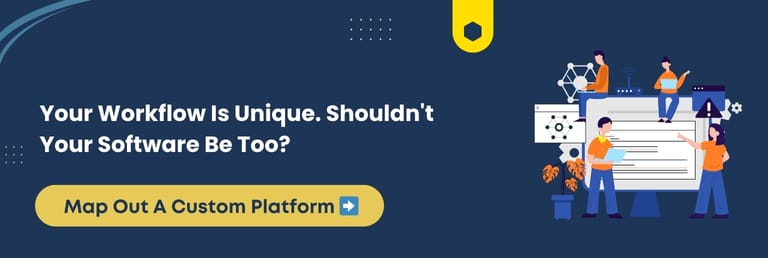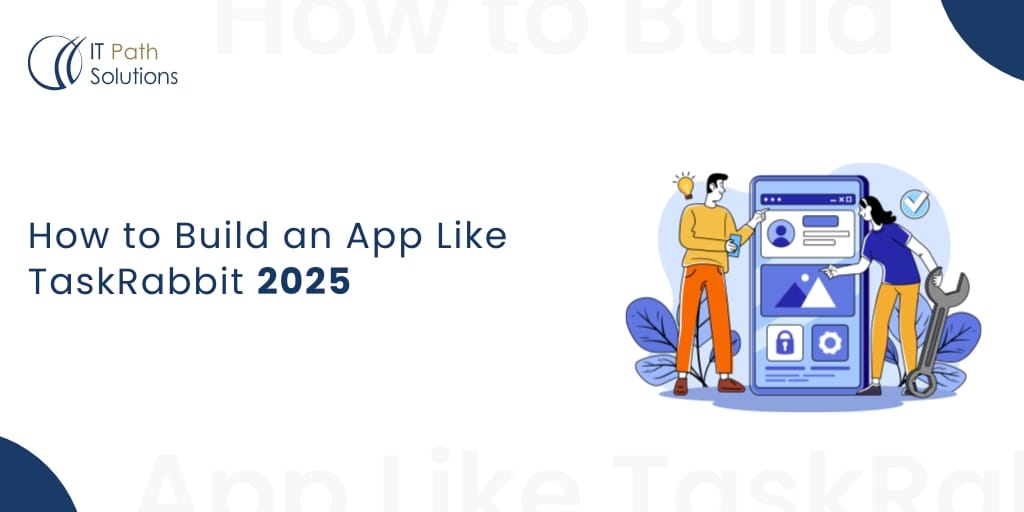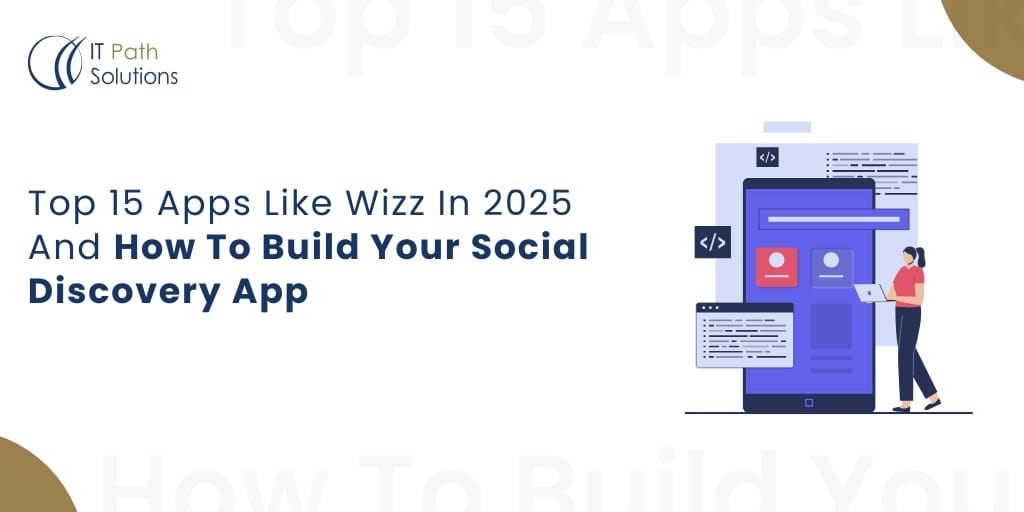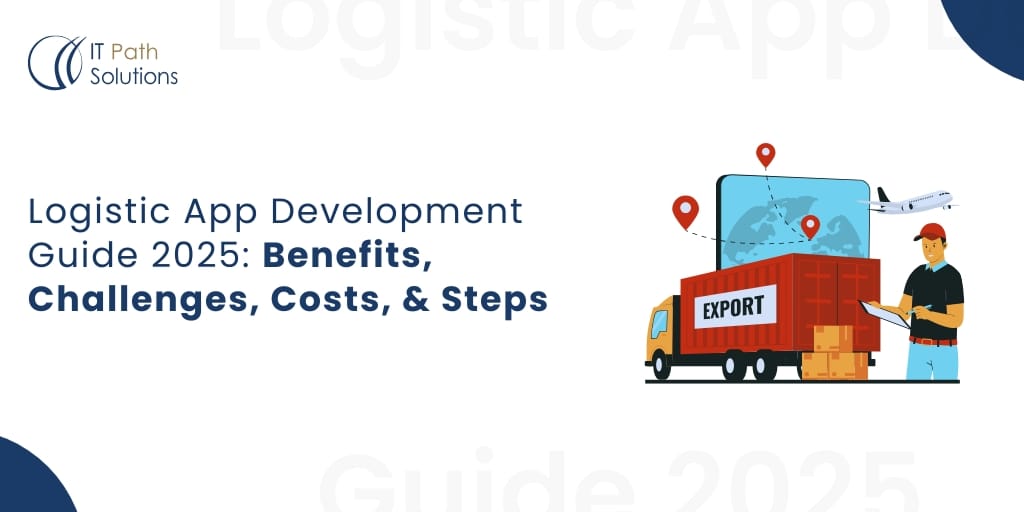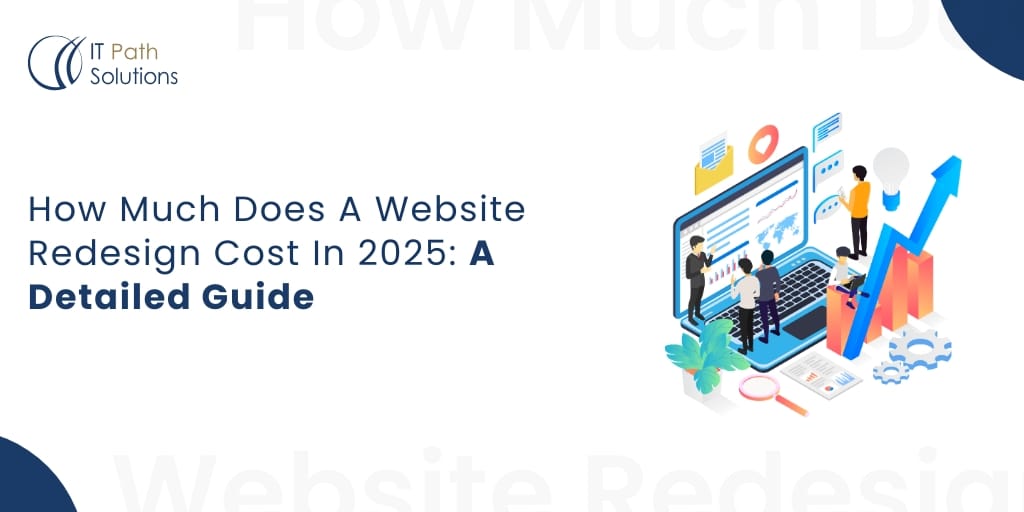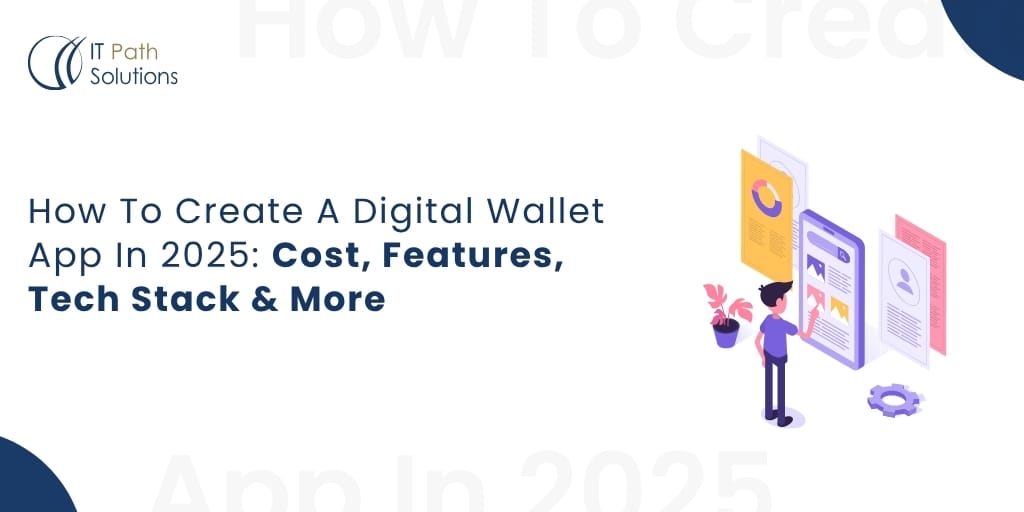How To Build And Choose The Best Real Estate Transaction Management Software In 2025
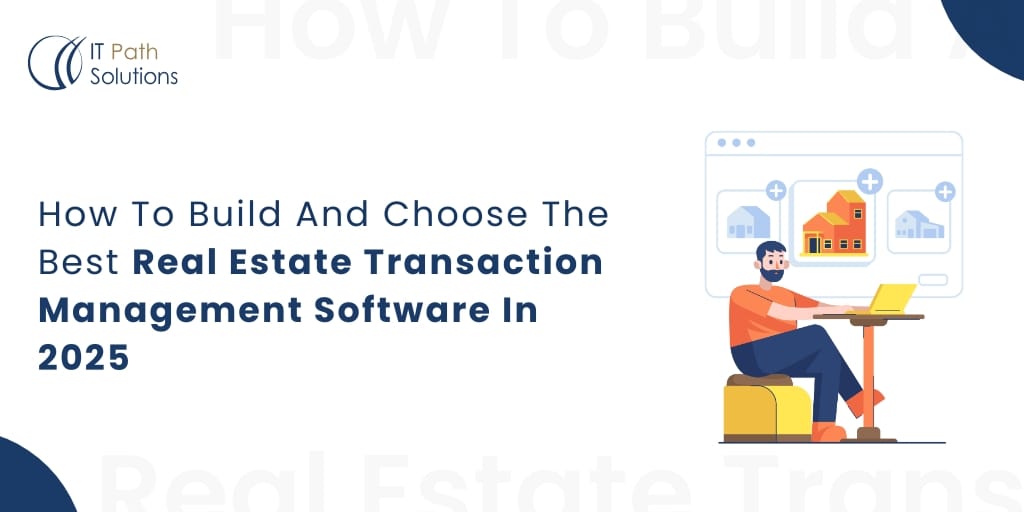
Picture this: A deal is about to close, but a missing signature ruins everything. Sometimes, it can be an outdated form, a lost email, or maybe scattered documents. That is all it takes for a transaction to spiral out of control. Now ask yourself, how often is that happening to your business?
If you are a real estate agent, brokerage leader, or executive decision-maker, you already know the stakes. You are managing high-value deals under constant pressure. Clients expect speed, precision, and transparency. But obsolete tools, disconnected systems, and manual checklists are holding you back.
It is where real estate transaction management software becomes a game-changer. It is not just a tool; it is an all-inclusive system to streamline workflows, store documents, track deadlines, and automate every touchpoint from listing to closing.
In this blog, we explain what real estate transaction software is, how it works, and how to choose or build the ideal platform for your business. You will also earn executive-level guidance, ROI insights, and tech trends shaping the future.
Let’s get started to help you eliminate the chaos and manage every step, document, signature, and communication.
What Is Real Estate Transaction Management Software And How Does It Work?
Every real estate deal involves hundreds of moving parts. Contracts, disclosures, signatures, deadlines, client conversations, and compliance requirements should align smoothly. However, without the ideal system in place, things can quickly get lost in the shuffle.
It’s where real estate transaction management software emerges as an effective solution.
It provides agents, brokers, and executives with a central hub where they can manage every aspect of the transaction. From storing paperwork to tracking milestones and communicating with clients, it replaces outdated processes with simple, digital workflows.
The Core Purpose
At its core, real estate transaction software is designed to simplify complex property deals. It handles:
- Secure document uploads and storage
- Task assignment and deadline reminders
- E-signatures and document approvals
- Total visibility across the deal lifecycle
- Communication and collaboration in one space
It is how real estate transaction software works behind the scenes to keep teams on track, clients informed, and deals moving forward without unnecessary delays.
Who Uses This Software?
- Real estate agents use it to organize transactions, submit offers, and close deals quickly.
- Brokerages rely on it to supervise compliance, monitor team performance, and reduce admin overhead.
- Executives and leadership teams use dashboards to oversee deal pipelines and make shrewd decisions.
Why It Matters In Today’s Market
In 2025, real estate is evolving rapidly. Clients expect instant responses. Teams work remotely. And regulations keep changing. Having a reliable real estate transaction software system in place is not just a convenience; it is a necessity for growth, trust, and scale.
What You Should Know: Real estate transaction management software brings clarity and control to even the most complex deals. It helps agents, brokers, and executives work innovatively, reduce risk, and deliver superior results with fewer manual steps.
Real Estate Workflow Automation: More Than Just E-Signatures
If you think real estate workflow automation is only about digital signatures, you’re missing the broad view. Today’s platforms have grown into intelligent, connected systems that handle the entire deal cycle with precision and ease.
From the initial client interaction to the final closing document, real estate workflow automation software streamlines tasks, minimizes manual work, and makes life easier for agents, brokers, and administrators.
Here’s what that looks like in action:
- Automated task creation assigns responsibilities based on the stage of the deal
- Deadline tracking helps keep every party accountable and on time
- Well-formulated checklists guide users through compliance steps and process milestones
- Instant notifications and reminders prevent bottlenecks and delays
And yes, e-signature functionality still plays a pivotal role. Real estate software includes e-signature, contracts, disclosures, and approvals that are signed securely and instantly. No more printing, scanning, or waiting.
But what makes this technology powerful is how it connects the dots. A signed document can automatically trigger the next task. Concluded steps update timelines in real time.
Everything works in sync, minimizing human error and accelerating the entire transaction. The chaotic set of manual steps is turned into a predictable, smooth experience for agents and clients alike.
Main Point: Real estate workflow automation software helps teams quickly wrap up deals, avoid costly mistakes, boost accuracy, and stay organized without getting buried in manual tasks.
Document Management & Compliance Tracking
Imagine this: You’re one day away from closing a dream-come-true property deal. Everyone is aligned. The buyer is ready, the seller is on board, and the agent has everything prepped. Then comes the email: “Where’s the signed disclosure document?” Panic sets in. It’s buried in someone’s inbox or stuck in a folder no one remembers. Suddenly, your seamless transaction turns into a fire drill.
That moment is why real estate document management software matters.
Modern compliance tracking real estate software is no longer just about storing PDFs. It’s about complete visibility, structured workflows, and proactive risk management. Whether you’re an agent, broker, or executive, centralizing your transaction documents ensures one thing: you’re always in control.
Why Centralized Document Storage Is A Game-Changer
Think of document management as your transaction’s control room. Everything from offer letters to inspection reports can be uploaded, tagged, organized, and accessed from one place. No digging. No duplication. No missed files.
With cloud-based real estate transaction software, your team can retrieve and update documents from anywhere. Whether they’re on-site with a client or working remotely, every file is available in real time. It is highly beneficial for commercial teams juggling dozens of deals at once.
Stay Compliant Without Constantly Worrying
Compliance tracking used to be a reactive task. You kept documents and hoped they were enough in case of an audit or legal review. Today, software handles it for you.
Automated audit trails log who accessed what, when, and why. You can also set document expiration reminders, flag missing disclosures, and ensure time-stamped signatures.
It is not a small thing. Regulatory bodies are tightening requirements. A misplaced document or unchecked box can mean costly delays or penalties. Real estate compliance software reduces human error and provides peace of mind.
Reduce Risk, Gain Trust
Clients feel the difference too. When your transaction process is smooth and paperless, it communicates professionalism.
There’s no “I’ll get back to you later” or “I can’t find that file.” Everything is immediate, transparent, and verified.
That level of operational maturity builds client trust and repeat business.
Must-Know Insight: Your deal flow is only as strong as your documentation. Whether you’re managing one transaction or a hundred, having a reliable, automated system to store, track, and verify documents is non-negotiable. It’s your silent partner in every deal.
Collaboration, CRM, And MLS Integrations
Visualize this: A buyer is ready to move forward, but your CRM shows a different stage than your MLS. Meanwhile, your transaction coordinator is waiting for a signed contract you emailed yesterday. This type of disconnection is more common than it should be.
Now, imagine a system where CRM, MLS, and collaboration tools are all connected. Data flows automatically. Everyone works in sync. That is the power of real estate transaction management software with CRM and MLS integration.
Real-Time Collaboration Inside The Platform
The best systems don’t require switching between email, Slack, spreadsheets, and cloud folders. They bring your entire team together within one platform.
Whether it’s an agent requesting a document from the legal team or a broker reviewing an offer, built-in messaging and task assignments keep communication centralized and easy to follow.
You can tag teammates, set due dates, and even allow external parties limited access to specific transaction files. All this minimizes confusion, accelerates approvals, and keeps your pipeline moving forward.
CRM And MLS Integration Made Simple
By integrating your CRM, every buyer or seller touchpoint becomes part of the transaction lifecycle. Lead data, communication history, and property preferences remain intact from initial contact to closing.
On the MLS side, synced listing data ensures that information stays accurate, eliminating manual entry and reducing listing errors. Many platforms now offer API integration features that allow custom syncing based on your tech stack.
Knowledge Drop: Disconnected systems slow down deals. By choosing a platform that offers real-time collaboration, CRM syncing, and MLS integration, you create a workflow that feels seamless, savvy, and quick.
Benefits Of Real Estate Transaction Software
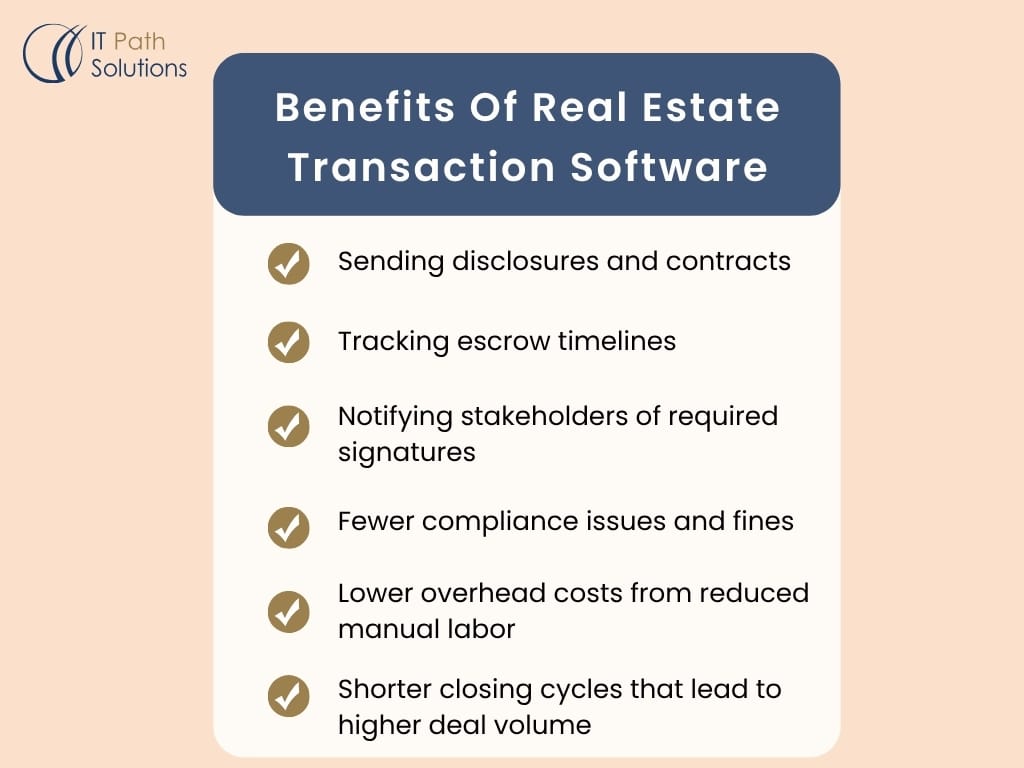
Let’s be honest. Real estate is a fast-paced industry where every delay can cost you a deal. That is why real estate transaction software has become more than just a nice-to-have tool. It is a necessity for agents, brokers, and executives who want to stay competitive, organized, and profitable.
Let us shed light on some impressive benefits.
Increased Efficiency And Deal Speed
Most users report that automation alone cuts down their transaction timelines considerably. When you have task reminders, document templates, and deadline alerts working together, it is more manageable to keep everything on track. No more missed follow-ups or last-minute scrambles.
You can automate routine steps such as:
- Sending disclosures and contracts
- Tracking escrow timelines
- Notifying stakeholders of required signatures
It frees up time so agents can focus on relationship-building instead of paperwork.
Improved ROI And Cost Savings
A typical question is whether these systems are worth the investment. The answer is clear when you look at operational efficiency. By decreasing the time spent on admin work, minimizing errors, and strengthening collaboration, you end up saving both time and money.
Companies often see:
- Fewer compliance issues and fines
- Lower overhead costs from reduced manual labor
- Shorter closing cycles that lead to higher deal volume
Firms using transaction software report better client satisfaction scores. Deals are wrapped up quickly. Communication is enhanced across departments. And decision-makers finally get the insights they need through real-time dashboards.
Main Message: Real estate transaction software is not just a tool; it is a strategic advantage that bolsters performance at every level of your operation.
Real Estate Software Use Cases By Role And Property Type

No two real estate professionals work precisely the same, yet they share one challenge: keeping transactions smooth and compliant at scale. Modern platforms adapt to each role and property class, delivering the appropriate tools where they matter most.
How Different Roles Benefit
Agents
- Centralize listings, offers, and client updates in one place
- Access paperwork on mobile devices during showings
- Track deadlines automatically so nothing is overlooked
Brokers and Brokerage Managers
- Monitor every transaction in a single dashboard
- Enforce policies with built-in checklists and approval flows
- Generate reports for productivity, compliance, and revenue
Executives and Owners
View performance metrics across offices or regions
Forecast revenue with real-time pipeline analytics
Minimize risk through audit-ready document trails
Property Type Considerations
Commercial Real Estate Transaction Software
- Handles multi-tenant leases, complex escrow terms, and large document sets
- Integrates with appraisal, zoning, and financing systems for seamless data flow
Residential Real Estate Transaction Management
- Speeds up single-family and condo closings with template-driven workflows
- Simplifies client communication through automated status updates and e-signature links
➡️Selecting a platform that supports both sectors saves training time and reduces tech sprawl. It also ensures teams can pivot between property types without switching tools.
Quick Recap: Transaction software adapts to every role and property category. Agents gain organization, brokers obtain oversight, and executives earn strategic insight. Commercial features manage scale, residential tools boost speed. One platform meets needs and drives growth confidently.
Build or Buy: Which Real Estate Transaction Software Model Is Right For You?

Visualize this: You find a software solution that promises to streamline transactions, but it’s too rigid to match your workflow. In contrast, a custom build offers flexibility but comes with prolonged timelines and development costs. Which one should you go for?
It is the question every forward-thinking brokerage or property firm might face.
Whether you’re an executive, a tech lead, or a brokerage owner, the choice between building or buying real estate transaction management software depends on your needs, growth plan, and budget.
There are generally three options you can explore. Each comes with its own pros and cons depending on where your organization stands today and where it wants to go tomorrow.
Off-the-Shelf Software
- Quick to implement with basic features
- Lower upfront cost compared to custom builds
- Limited flexibility in workflows and integrations
- Vendor dependency for upgrades and support
➡️It is ideal for small teams or those new to transaction platforms.
Custom Real Estate Transaction Management System
- Tailored workflows and branding
- Integrates flawlessly with your CRM, MLS, and internal tools
- You own the roadmap, ensuring future-proofing
- Higher upfront investment, but substantial long-term ROI
➡️It is perfect for growing teams with complex or evolving operations.
Enterprise Solutions
- Scalable architecture for multi-location brokerages
- Compliance management across jurisdictions
- Executive dashboards for performance and reporting
- A blend of prebuilt modules and custom extensions
➡️This option is highly favorable for firms requiring robust reporting, multi-office collaboration, and advanced automation.
Decision Framework
Ask these key questions:
- Do we need industry-standard features or tailored workflows?
- Will we scale in the next 1 to 2 years?
- Do we have internal tech support for custom builds?
- What is our total cost of ownership over 3 to 5 years?
What This Means For You: The best-fit software model depends on your business size, goals, and resources. Align your choice with your long-term strategy to ensure flexibility, scalability, and measurable value over time.
How To Build Real Estate Transaction Software: A Developer’s Guide

Once you’ve decided to build your own real estate transaction management platform, the next step is execution. This section walks you through how to architect, design, and launch a software solution that not only works but scales with your growth.
Step 1: Choose The Right Tech Stack
Commence with the foundation.
Most successful platforms use a cloud-native architecture (AWS or Azure), along with modern frameworks like React or Angular for the front end, and Node.js or Python for the backend.
Mobile apps should be built with native or cross-platform tools like or Flutter React Native for seamless experiences.
Step 2: Focus On Core Modules
Prioritize building these modules first:
- Document management with secure cloud storage
- Workflow automation for transactions
- Compliance tracking
- CRM and MLS integrations
- E-signature and approval systems
Custom workflows tailored to residential or commercial transactions help differentiate your solution.
Step 3: Design With Users In Mind
Use wireframes and prototypes to validate the UI before complete development. Focus on simplicity, speed, and usability. Every click should serve a definite purpose. Mobile responsiveness is paramount.
Step 4: Post-Launch Readiness
Plan for software onboarding, team training, and technical documentation. Include admin dashboards, analytics, and robust permissions to support scale. Implement ongoing support channels to assist users in real time.
The Bottom Line: Successful real estate software development blends technical strength with rich domain knowledge. Focus on real-world use cases, user experience, and backend scalability to future-proof your platform from day one.
Advanced Technology In Transaction Management: AI And Blockchain
Visualize a world where transactions never fall through the cracks, documents authenticate themselves, and compliance issues are detected before they ever become a problem. It is not a distant dream. Artificial intelligence and blockchain are already reshaping the way real estate transaction software performs at every level.
AI Is Your Tireless Digital Strategist
Artificial intelligence is not about replacing humans; it is about enhancing decision-making, saving time, and boosting accuracy. AI-powered platforms can:
- Predict closing delays based on deal history and activity patterns
- Automatically generate reminders for key deadlines
- Flag compliance gaps or missing documents
- Offer intelligent suggestions based on previous workflows
Some solutions already use conversational AI to guide clients through onboarding and auto-generating summaries of dense legal paperwork. These features enable agents and brokers to focus on people, not processes.
Blockchain Brings Bulletproof Transparency
Blockchain is not just for cryptocurrencies. In real estate, it is being used to:
- Create tamper-proof audit trails
- Secure ownership records and contracts
- Enable self-executing agreements once conditions are met
➡️Imagine a digital contract that autonomously releases commission payments the moment a deal is concluded. No paperwork. No delays. No errors. Blockchain injects integrity into every transaction and safeguards sensitive data, especially in high-stakes commercial deals.
Key Takeaway: AI and blockchain are not just futuristic tools. They are transformative forces in transaction management, delivering automation, transparency, and peace of mind that legacy systems fail to offer.
Real Estate Software For Executives: ROI, Features, And Selection Guide
For executives leading real estate enterprises, software is not just a tool; it is a strategic asset that can stimulate growth, reduce overhead, and create a distinct market edge. However, with countless options on the market, how do you select a platform that aligns with your firm’s long-term goals?
What Executives Should Prioritize
Unlike agents or brokers, executives view software through a broader lens. Key decision points include:
- Company-wide scalability that can handle multi-region or multi-brand operations
- Data centralization for sharp-witted forecasting and reporting
- Robust role-based access that protects sensitive information while empowering teams
- Custom dashboards that give a comprehensive view of transactions, revenue, and pipeline
Think of your software as a command center. It should not only streamline operations but also uncover trends, reduce friction, and unlock shrewder strategies.
Real ROI, Not Just Time Saved
A robust transaction platform delivers more than convenience. It offers measurable ROI through:
- Reduced deal fallouts due to better coordination
- Lower legal and compliance risks through automation
- Faster closings, meaning quicker revenue recognition
Several brokerages have reported double-digit efficiency gains and significant cost reductions within the first year of implementing enterprise-grade platforms.
➡️Your evaluation should go beyond price or popularity. Look at flexibility, integration capabilities, customer support maturity, and vendor roadmaps. Opt for platforms that evolve with your business rather than constrain it.
Core Insight: The right transaction software is a strategic powerhouse. It aligns with leadership goals, fuels performance, and provides executives with the clarity and control to steer the company forward.
SkySlope Alternatives And Best Transaction Software Compared
SkySlope may be a familiar name in the world of real estate transaction management, but it is far from the only contender. In fact, the evolving needs of modern brokerages, agents, and executives have given rise to a wave of robust platforms that bring fresh perspectives and refined workflows to the table.
Why Look Beyond SkySlope?
Many users of SkySlope eventually seek:
- A more elegant and intuitive interface
- Timely feature updates and responsive support
- Superior customization and integration depth
- A system that evolves with their business model, not around it
It is where alternatives stand out. They do not just mirror SkySlope’s feature set. They often reimagine it from scratch.
Top Contenders Making An Impression
Let us explore a few names that have garnered attention:
| Tool | Best For | Unique Edge |
| REsimpli | Investors and hybrid teams | Combines simplicity with deal-focused automation and deep control |
| Dotloop | Distributed teams and remote agents | Enables seamless collaboration and document sharing with built-in compliance |
| Brokermint | Brokerages and large real estate offices | Offers integrated commission tracking and detailed agent management workflows |
| Paperless Pipeline | Small to mid-sized teams | Focuses on speed, transparency, and lightweight transaction coordination |
Each has a distinctive flavor. The right one depends on your firm’s scale, goals, and how you want your technology to perform under pressure.
Key Gaps In The Market
Even with dozens of platforms available, many still fall short in:
- Real-time predictive analytics
- Seamless migration from legacy systems to AI-powered ones
- Role-specific experiences that go beyond surface-level personalization
It is where custom-built transaction software shines. If your workflows, reporting needs, or vision go beyond what templates can support, a tailored solution is practical. It gives you the precision and freedom that most off-the-shelf tools cannot.
The Crux: SkySlope paved the way, but today’s real estate landscape offers platforms that deliver more precision, control, and flexibility. Select the tool that mirrors your vision, not just your process.
Challenges In Real Estate Transaction Management And Best Practices
Imagine concluding a deal only to realize a critical document was missed, or compliance slipped through the cracks. These aren’t rare errors. They’re common hurdles faced by agencies and brokerages, often costing time, money, and reputation.
So, what gets in the way?
Common Roadblocks
- Fragmented Communication: Emails, texts, calls, and sticky notes all trying to coordinate one transaction often lead to misalignment.
- Manual Document Handling: Files get misplaced or mislabeled without a unified system, and duplicate entries become a daily struggle.
- Compliance Confusion: Regulations vary by region, and keeping up can feel like chasing a moving target.
- Resistance to Technology: Agents and teams often stick to “what’s familiar,” delaying tech adoption that could solve half their problems.
Best Practices To Streamline Operations
- Implement Real-Time Dashboards: Visibility into task status, deal stages, and document flow prevents surprises and keeps stakeholders aligned.
- Centralized Document Management: A single source of truth reduces errors and simplifies audits.
- Automate Routine Tasks: Reminders, task assignments, and deadline tracking reduce manual follow-ups and human error.
- Train with Intention: Introducing new tools is not enough. Ongoing education helps teams feel confident, not overwhelmed.
- Prioritize Communication Flows: Set clear protocols for messaging, updates, and approvals. The fewer tools in play, the better.
Essential Insight: Transaction chaos often arises from avoidable issues. By blending the right tools with process discipline, real estate teams can turn friction into fluidity at every deal stage.
Final Action Plan: Bringing It All Together
You’ve explored the features, evaluated the models, and compared the top contenders. Now comes the pivotal moment. Execution.
A well-orchestrated action plan is what separates high-performing real estate firms from those still struggling with inefficiencies and outdated systems. So, how do you ensure your next step is both confident and calculated?
Here is a structured roadmap to guide your decision:
Assess Your Current Workflow
Identify bottlenecks, compliance risks, and communication gaps. It will help you determine what your ideal transaction management system must solve.
Involve Key Stakeholders
Loop in brokers, agents, compliance officers, and tech leads early. Their insights will shape requirements and improve adoption rates later.
Define Your Feature Priorities
Is MLS integration critical? Do you need mobile access for on-the-go agents? Rank features based on daily operational value, not just “nice-to-haves.”
Choose The Right Engagement Model
If your needs are very precise, consider custom development. Explore configurable white-label solutions with expert vendors if you want speedier rollout and proven results.
Create A Realistic Implementation Timeline
Set clear milestones for onboarding, training, data migration, and testing. Manage each phase tightly to avoid disruptions.
Partner With The Right Tech Experts
Look for a development partner who understands real estate intricacies, supports compliance, and offers scalable architecture.
Final Thought: A thoughtful action plan rooted in your goals and grounded in execution is what transforms software into strategy. It’s not just about choosing a tool; it’s about choosing momentum.
Conclusion
In the dynamic world of real estate, efficiency is more than a competitive edge; it is a necessity. Transaction management software is no longer optional; it is a foundation for operational excellence, client satisfaction, and long-term growth.
You have seen how the right platform can streamline workflows, reduce compliance risks, and create seamless experiences across every stage of the deal. However, software alone is not the magic. The real transformation lies in how strategically you implement it.
Whether you build a custom solution from the ground up or partner with a seasoned development company for a tailored product, the future belongs to those who act with clarity and purpose.
Choose a path that reflects your ambition and back it with a solution built to perform.
If you are ready to elevate your real estate operations and want a trusted partner to bring that vision to life, our team is all set to collaborate, strategize, and deliver. At IT Path Solutions, we do more than code; we craft digital ecosystems that empower businesses to thrive.
Take the first step today. Your vision deserves a solution that is built to lead.
FAQ
How Long Does It Take To Develop Real Estate Transaction Management Software?
Development time typically ranges from 3 to 6 months, depending on feature complexity, customization needs, and integration requirements. A thoughtfully formulated project roadmap and agile development approach can help speed up timelines without compromising quality.
What Is The Average Cost Of Custom Transaction Management Software?
Custom real estate transaction management software can cost anywhere between $20,000 and $100,000 or more. It varies based on the tech stack, functionality, security layers, and third-party integrations required. Getting a customized quote is highly recommended.
Does This Software Support Remote Real Estate Teams?
Yes, cloud-based real estate transaction software supports remote collaboration. It empowers agents, brokers, and clients to access documents, track progress, and communicate from anywhere using secure, centralized platforms.
Can This Software Be Customized For Commercial Real Estate Firms?
Absolutely. Many real estate transaction platforms can be tailored to meet commercial workflows. It includes multi-party deals, lease tracking, zoning compliance, and custom reporting suited for large-scale property transactions.
How Secure Is Real Estate Transaction Management Software?
High-quality platforms are built with bank-grade encryption, role-based access controls, audit trails, and multi-factor authentication to protect sensitive data. Always confirm that the solution complies with relevant regulations such as GDPR or CCPA.
 Healthcare
Healthcare  Education
Education  Real Estate
Real Estate  Logistic
Logistic  Themes
Themes
 Plugins
Plugins
 Patterns
Patterns
